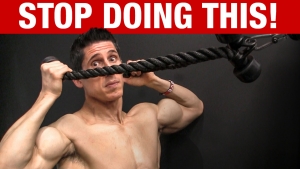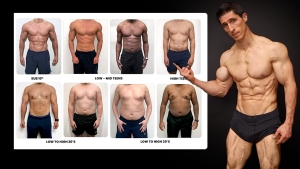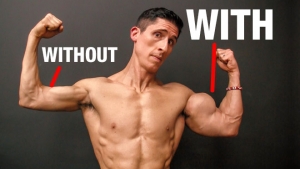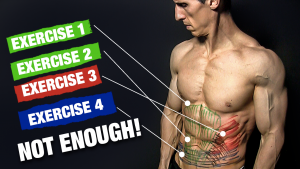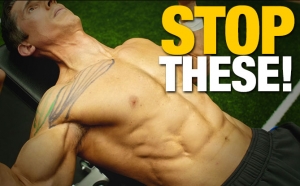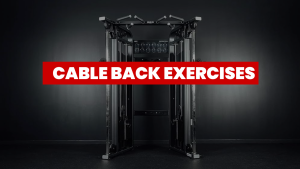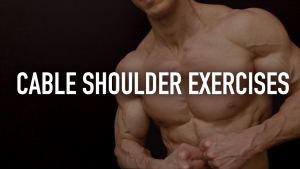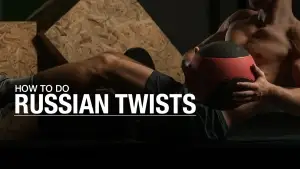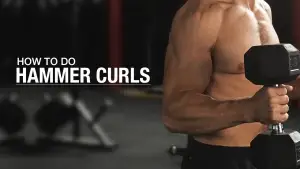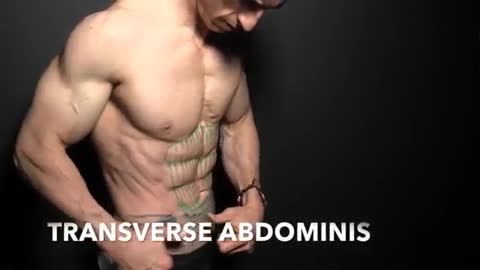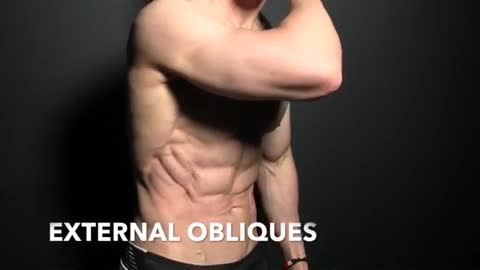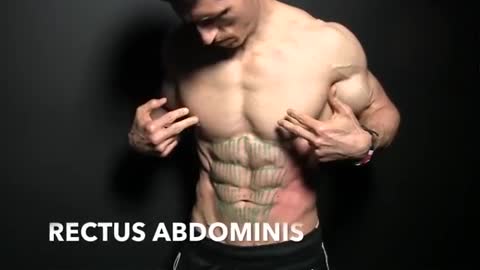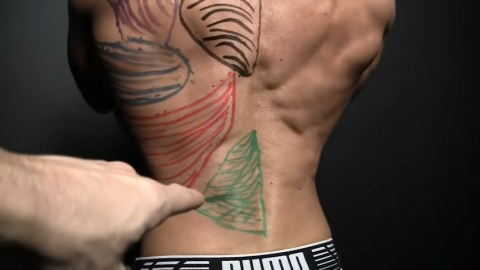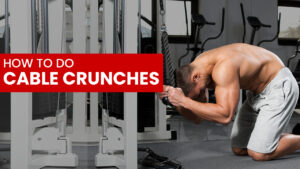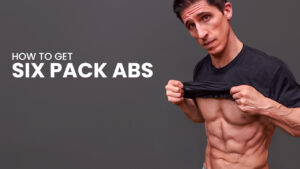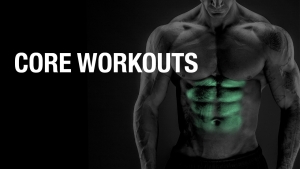
WHY DO THE pallof PRESS?
Your core isn’t built to move. It’s built to resist movement.
And if you’re not training that function directly, especially through anti-rotation exercises, you’re missing out on strength, stability, and performance.
What’s more, most guys chasing a six-pack think the rectus abdominis is the only muscle that matters. But if you’re serious about building a core of steel, you need to train the entire core.
The Pallof Press is a functional core strengthening exercise that puts most core finishers to shame.
It might look like a simple isometric movement but don’t be fooled. This dynamic core stability exercise trains muscle coordination control, core under load, and the kind of core stabilization that transfers to real-world lifts and athletic performance.
Let’s cover the muscles that the Pallof Press targets, how to do the Pallof Press, and the most common mistakes to avoid.
PALLOF PRESS: MUSCLES WORKED
You can’t build a strong core if you don’t understand what the core actually is. And we’re not just talking about abs here.
We’re talking about a deep, interconnected system of stabilizers that protect your spine, resist force, and transfer power across the entire body. The Pallof Press targets the muscles that do exactly that.
Here’s what’s really working when you lock into that outstretched position and refuse to let your torso twist even when your body is begging to rotate.
TRANSVERSE ABDOMINIS (TVA)
The transverse abdominis is the deepest layer of abdominal muscle. It wraps around your midsection horizontally like a corset.
This muscle acts as a natural weight belt, providing stability to your spine and abdominal cavity.
As you press the band or cable out during the Palloff Press, the TVA fires to keep your core tight and your spine in a neutral position.
It’s your first line of defense against rotation and extension. Without it, you’d fold under even a light band, let alone a medium-heavy resistance band.
INTERNAL OBLIQUES
The internal obliques run diagonally from your lower ribs to your pelvis, beneath the external obliques.
They help with rotation and side-bending, but more importantly, they resist those movements when you need to stay stable.
During the Pallof Press, your internal obliques contract hard to resist the pull of the band or cable pulley, especially when your torso is tempted to twist toward the anchor point.
They help you lock into that optimal position with shoulders stacked and hips square.
EXTERNAL OBLIQUES
The external obliques sit on top of the internal obliques, running diagonally in the opposite direction from the ribs down and in toward the midline.
External obliques assist in trunk rotation and lateral flexion, but just like the internal obliques, they shine in resisting those movements during stabilization exercises.
During the exercise, the external obliques create tension to stop rotation in the opposite direction of the resistance, working alongside the internal obliques to form a bracing wall across your torso.
This is core activation with real-world application. Think heavy compound lifts, not just a core workout every day.
RECTUS ABDOMINIS
The famous “six-pack” muscle runs vertically down the front of your abdomen.
The all-important rectus abdominis flexes the spine (like during Crunches) but also stabilizes the trunk during load-bearing movements.
The rectus abdominis keeps your ribs from flaring and your spine from arching when the band is pulling you off balance.
It locks your torso into position and supports the press without movement, just pure tension.
ERECTOR SPINAE
The erector spinae is a group of muscles that run vertically along your spine, from your lower back up to the neck.
They extend and stabilize the spine, especially during lifting and posture-demanding movements.
During the Pallof Press, these muscles keep your spine upright and prevent collapse or over-extension as you press.
BENEFITS OF THE PALLOF PRESS
The Pallof Press is real-deal training that strengthens your core muscles, locks in perfect form, and gives your body the kind of bulletproofing you need under a heavy load.
Here’s why the Pallof Press should be a staple in your core workout every day (or at least every training week).
BUILDS REAL-WORLD CORE STRENGTH
Your core’s not just there to look good. It’s there to hold the line when chaos hits.
Whether you’re hit on the field, under a barbell, or twisting to grab something in the backseat, the Pallof Press conditions your torso to stay rock solid when your spine is pulled in every direction.
By forcing your body to resist force, not produce it, this move creates the kind of deep, reflexive core strength that Crunches and Cable Twists just can’t touch.
REINFORCES PROPER POSTURE UNDER LOAD
You don’t get to slouch during this one. To nail the Pallof Press, you need optimal form. That means stacked shoulder blades, a tall spine, and a rock-solid midsection.
It teaches your upper body to maintain alignment while your core muscles and lumbar spine absorb force.
That’s posture you can take into the power rack on your heavy lifts and keep out of the physical therapist’s office.
IMPROVES TOTAL-BODY CONTROL AND COORDINATION
It’s not just about abs. The Pallof Press lights up the arm muscles, shoulder blades, outer glutes, and even your feet as stabilizers.
You’re holding tension from head to toe regardless of if you use a medium-weight resistance band or cable stack.
This type of core training doesn’t just look good. It improves control during movements across your entire body.
TEACHES YOU TO BRACE LIKE AN ATHLETE
What do plank shoulder stability, deadlift performance, and barbell pressing all have in common?
They are all about bracing.
And the Pallof Press teaches you to brace in a holding position without bouncing or twisting, just pure tension.
It’s one of the best core stability exercises for building that instinct to stay tight, even with a heavier band or a max-effort lift on your back.
SCALES TO ANY SKILL LEVEL
Beginner? Grab a lighter band or set the cable machine to low resistance.
Advanced? Use a heavier band, up the cable machine weight, or try the half-kneeling position for added instability.
The Pallof Press adapts to your level. No fancy cable machine required.
BURNS FAT? NOT DIRECTLY, BUT…
No, the Pallof Press isn’t a fat-burning miracle.
But if you’re dialing in your body fat percentage, the Pallof Press helps build definition and strength in deep core muscles most people ignore.
Want that lean, athletic midsection that works under pressure? This is the core movement to earn it.
TRANSFERS TO EVERY LIFT, SPORT, AND MOVEMENT PATTERN
From rotational sports to squatting, pressing, pulling, and sprinting, this functional exercise makes your body better at it.
You’ll move better, brace harder, and recover faster. It’s one of the few isometric exercises with massive benefits for literally everything you do.
HOW TO DO THE PALLOF PRESS
Most core exercises look tough, but they don’t train you to be tough. The Pallof Press does.
This isn’t about crunching or twisting. This is about locking your spine down like a vault.
The Pallof Press builds the kind of core stability that holds up when your body wants to fold.
Here’s how to perform the Pallof Press with proper form:
PALLOF PRESS


HOW TO DO THE PALLOF PRESS:
- Attach a resistance band or set up a Cable Pallof Press using a cable weight stack at cable to chest height.
- Stand sideways to the anchor, feet shoulder-width apart and brace your core tight.
- Hold the handle with both hands directly in front of your chest.
- Plant your feet and engage the glutes. You want a strong foundation with a neutral spine and no wobble.
- Now press the handle straight out and extend until your arms are fully locked out in front of you.
- The tension is trying to yank you back toward the anchor. That’s the whole point. Your job is to keep everything frozen. No twisting, no turning, no leaning.
- Pull the handle back to your chest slowly. Maintain your position, keep your body movement minimal, and don’t let those hips shift.
- Pause for a moment and repeat.
WHAT MAKES IT EFFECTIVE: What makes the Pallof Press so effective is its simplicity. It forces your core to resist rotation, which is exactly what it’s built to do. By challenging your stability in a controlled, isometric holding pattern, it builds deep, functional strength that carries over to every lift, sport, and real-life movement.
PALLOF PRESS COMMON MISTAKES
The Pallof Press looks simple until you do it wrong.
This isn’t just a press. It’s a core anti-rotation stability exercise that demands full-body control, precision, and tension.
If you’re chasing the alluring benefits of excellent core stability, don’t fall into these traps:
ROTATING THE TORSO DURING THE PRESS
This is the cardinal sin. Your job in the Pallof Press is to resist rotation, not give into it.
If your shoulders turn toward the anchor point or you twist even slightly during the outstretched position, you’re not training stability, you’re reinforcing bad habits.
Brace like you’re about to get punched in the gut. Keep your shoulders stacked, chest forward, and torso locked in place.
Think of it like holding the bottom of a plank position. Any sag, shift, or wobble means your core muscles aren’t doing their job.
PRESSING WITHOUT BRACING THE CORE AND GLUTES
Extending your arms is only half the movement. If your core muscles and glutes aren’t firing, the band or cable will pull your body out of alignment and expose weak points.
You’ll lose tension fast, and that means losing results.
Before pressing, lock in your base like you’re about to unrack a power clean or drop into a squat position. Squeeze your glutes, draw the ribs down, and stay rigid.
This isn’t a lazy press. It’s an active, full-body core movement.
LETTING THE BAND OR CABLE SNAP YOU BACK
Fast reps destroy form. If you’re letting the resistance band or cable machine yank your arms back, you’re not controlling the eccentric portion of the rep and that’s where the real stability gains happen.
Treat the return like its own rep. Control the handle back to your chest slowly, keeping your posture tall and your core tight.
USING TOO MUCH RESISTANCE TOO SOON
Grabbing the heavier band or maxing the cable weight stack might feel impressive, but if you can’t maintain alignment, you’re training dysfunction.
More resistance means more challenge, but only if you earn it with proper form.
Start with lighter bands or medium-weight resistance bands.
Focus on keeping your body stable from head to toe. Progression should come from mastering the movement, not just adding load.
POOR BODY ALIGNMENT AND FOOT POSITION
Standing like you’re waiting in line at the grocery store? That’s a fast track to instability.
If your stance is off, your knees are bent unevenly, or your spine is hyperextended, the entire movement collapses.
Set your feet shoulder-width apart, stack your spine tall, and keep a neutral spine throughout.
Think athletic stance, like you’re prepping for a glute exercise or setting up for a deadlift. Every inch matters when you’re training stability.
This isn’t your average 7-minute intense core workout that leaves you sweaty but unstable. This is your go-to if you want powerful core stability and a body that resists rotation like a brick wall.
By training your body to resist rotation under tension, it builds stability that shows up in every lift, movement, and sport.
Skip the gimmicky core exercises. Master this one core anti-rotation stability exercise, and you’ll feel the difference where it matters most.
Check out our complete line of ATHLEAN-RX Supplements and find the best training program for you based on your fitness level and goals.
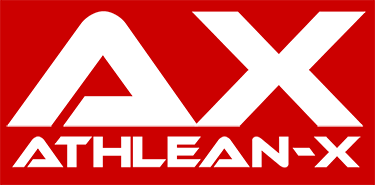
- The Pallof Press doesn’t just sculpt your abs. It hardwires stability into every lift, twist, and stride.
- This anti-rotation core exercise is one of the best ways to functionally strengthen and define your midsection
- Here’s how to do the Pallof Press:
- Anchor a resistance band or set up a cable machine so it’s lined up at your mid-chest level.
- Stand sideways to the anchor point, feet set just wider than shoulder-width.
- Grip the handle with both hands at the center of your chest. Elbows tucked. Lats on. Core braced like you’re about to take a punch.
- Squeeze your glutes and stand tall. Your spine should be neutral, not arched, and your ribs shouldn’t flare.
- Now press the handle straight out. Your arms are extending, but your job is not to move anywhere else. Do not allow your torso to rotate. Hold this position.
- Return the handle slowly and under control.
PALLOF PRESS FAQ
The Pallof Press doesn’t hit just one muscle. It targets your entire core system.
That includes the transverse abdominis, internal and external obliques, and rectus abdominis, but it doesn’t stop there.
You’re also recruiting stabilizers like the erector spinae, glutes, lats, and even your shoulder stabilizers.
It’s a full-body isometric assault that teaches your body to resist force instead of just flexing and crunching. This is how real-world core strength is built.
Leg Raises train hip flexion with a little ab involvement if your form is perfect. But most people end up swinging, compensating, and torching their lower back.
The Pallof Press, on the other hand, teaches your core to do its actual job: resist unwanted movement, stabilize the spine, and keep your body under control when chaos hits.
If you want strong abs that actually do something, choose the move that builds function, not just fatigue.
Absolutely! It’s one of the most underrated exercises in the entire gym. It looks simple, but it’s one of the hardest moves to do right, and one of the most rewarding when you do.
If you care about injury prevention, stability under heavy loads, or just being an athlete who moves well, the Pallof Press deserves a permanent spot in your training.
Ignore it, and you’re missing one of the most important tools for real core strength.
REFERENCES
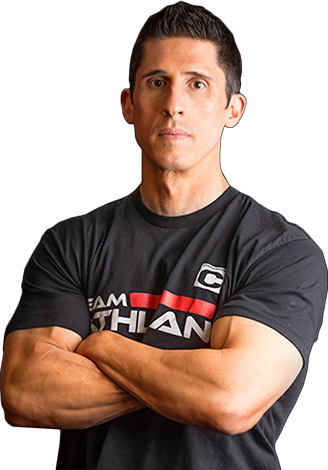
Jeff Cavaliere M.S.P.T, CSCS
Jeff Cavaliere is a Physical Therapist, Strength Coach and creator of the ATHLEAN-X Training Programs and ATHLEAN-Rx Supplements. He has a Masters in Physical Therapy (MSPT) and has worked as Head Physical Therapist for the New York Mets, as well as training many elite professional athletes in Major League Baseball, NFL, MMA and professional wrestling. His programs produce “next level” achievements in muscle size, strength and performance for professional athletes and anyone looking to build a muscular athletic physique.
